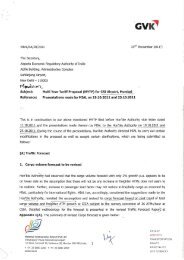Annexure II - AERA
Annexure II - AERA
Annexure II - AERA
You also want an ePaper? Increase the reach of your titles
YUMPU automatically turns print PDFs into web optimized ePapers that Google loves.
NERA<br />
t:CO<strong>II</strong>OlJ1IC COllsul:in9<br />
activities from the regulatory till (e.g. UK, Ireland, etc.). Therefore, with the term "single till",<br />
we refer also to those approaches in which some non-aeronautical activities are excluded from<br />
the regulatory till.<br />
Under a single till approach, revenues that airport is allowed to receive from aeronautical<br />
services (defined as "allowed revenues") are calculated as difference between (i) total allowed<br />
costs (i.e remuneration on capital, depreciation and opex, related to both aeronautical activities<br />
and non-aeronautical activities included in the regulatory till) and (ii) revenues from nonaeronautical<br />
activities included in the regulatory till.<br />
Dual till approach<br />
Under a dual till framework, only those activities in which airport has market power (generally,<br />
those services which rely on "bottlenecked" facilities) are considered in tariff calculation. Under<br />
this approach, allowed revenues are assessed considering exclusively allowed costs (i.e<br />
remuneration on capital, depreciation and opex) associated with aeronautical activities. Revenues<br />
and costs of non-aeronautical activities are not taken into account in setting regulated tariffs.<br />
Hybrid till approach<br />
<strong>Annexure</strong> <strong>II</strong>-B<br />
Under a hybrid till framework, the airport cost basis is determined based on a combination of the<br />
single till and the dual till approaches. A hybrid till regime may be structured in a variety of<br />
ways. For example, a hybrid till framework may prescribe that costs to be considered in tariff<br />
determination are exclusively costs associated with aeronautical activities and that a predefined<br />
percentage of non-aeronautical revenues is used to defray the cost base for charges.<br />
Alternatively, a hybrid till framework may prescribe that the regulatory till includes both<br />
aeronautical activities and a predefined percentage (e.g. 50%) of non-aeronautical activities; this<br />
implies that aeronautical costs are reduced of an amount equal to the predefined percentage of<br />
the commercial margin (calculated as difference between non-aeronautical revenues and nonaeronautical<br />
costs, including remuneration on capital, depreciation and opex) that accrues to the<br />
airport.<br />
CP No. 9/2013-14/T-12023(14)/1/2012- Tariff- Vol - <strong>II</strong>I <strong>Annexure</strong> <strong>II</strong>-B Page 29 of 51<br />
12
















